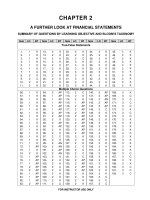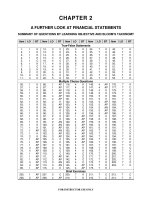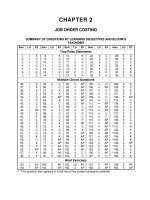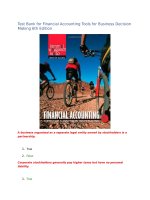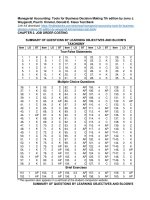Accounting tools for business decision making 7 kieo ch11
Bạn đang xem bản rút gọn của tài liệu. Xem và tải ngay bản đầy đủ của tài liệu tại đây (1.01 MB, 94 trang )
Accounting: Tools for Business Decision Making
Seventh Edition
Kimmel; Weygandt; Kieso
Chapter 11
Reporting and Analyzing Stockholders’ Equity
Prepared by
COBY HARMON
University of California, Santa Barbara
Westmont College
This slide deck contains animations. Please disable animations if they cause issues with your device.
Chapter Outline:
Learning Objectives
LO 1
Discuss the major characteristics of a corporation.
LO 2
Explain how to account for the issuance of common, preferred, and treasury stock.
LO 3
Explain how to account for cash dividends, stock dividends, and stock splits.
LO 4
Discuss how stockholders’ equity is reported and analyzed.
Copyright ©2019 John Wiley & Sons, Inc.
2
Learning Objective 1
Discuss the Major Characteristics of a Corporation
LO 1
Copyright ©2019 John Wiley & Sons, Inc.
3
Corporate Form of Organization
An entity separate and distinct from its owners.
LO 1
Copyright ©2019 John Wiley & Sons, Inc.
4
Characteristics of a Corporation (1 of 2)
Characteristics that distinguish corporations from proprietorships and partnerships
Advantages
Separate legal existence
Limited liability of stockholders
Transferable ownership rights
Ability to acquire capital
Continuous life
Corporation management
LO 1
Copyright ©2019 John Wiley & Sons, Inc.
5
Characteristics of a Corporation (2 of 2)
Characteristics that distinguish corporations from proprietorships and partnerships:
Disadvantages
Corporation management
Government regulations
Additional taxes
LO 1
Copyright ©2019 John Wiley & Sons, Inc.
6
Corporation Organization Chart
LO 1
Copyright ©2019 John Wiley & Sons, Inc.
7
Other Forms of Business Organization
•
Limited partnerships
•
Limited liability partnerships (L LPs)
•
Limited liability companies (L LCs)
•
S-Corporations
•
•
LO 1
No double taxation
Cannot have more than 100 shareholders
Copyright ©2019 John Wiley & Sons, Inc.
8
Forming a Corporation
Initial steps of forming
•
•
•
File application with Secretary of State
State grants charter
Corporation develops by-laws
Companies generally incorporate in a state whose laws are favorable to the corporate form of business.
Corporations engaged in interstate commerce
LO 1
must obtain a license from each state in which they do business.
Copyright ©2019 John Wiley & Sons, Inc.
9
Stockholder Rights (1 of 3)
1.
Vote in election of board of directors at annual
meeting and vote on actions that require
stockholder approval.
2.
LO 1
Share the corporate earnings through
receipt of dividends
Copyright ©2019 John Wiley & Sons, Inc.
10
Stockholder Rights (2 of 3)
3.
LO 1
Keep the same percentage ownership when new shares of stock are issued (preemptive right)
Copyright ©2019 John Wiley & Sons, Inc.
11
Stockholder Rights (3 of 3)
4.
LO 1
Share in assets upon liquidation in proportion to their holdings. This is called a residual claim because owners are paid with assets that remain after all other claims have been paid.
Copyright ©2019 John Wiley & Sons, Inc.
12
Stock Certificate
LO 1
Copyright ©2019 John Wiley & Sons, Inc.
13
Stock Issue Considerations (1 of 5)
Authorized Stock
•
Charter indicates the number of shares of stock that a corporation is authorized to sell
•
Number of authorized shares is often reported in stockholders’ equity section
LO 1
Copyright ©2019 John Wiley & Sons, Inc.
14
Stock Issue Considerations (2 of 5)
Issuance of Stock
•
Corporation can issue common stock
•
•
LO 1
Directly to investors or
Indirectly through an investment banking firm
Copyright ©2019 John Wiley & Sons, Inc.
15
Stock Issue Considerations (3 of 5)
Par and No-Par Value Stocks
•
Par value stock has been assigned a value per share
•
Years ago, par value determined legal capital per share that a company must retain in business for protection of corporate creditors
•
Many states do not require a par value
•
No-par value stock is fairly common
•
In many states, the board of directors assigns a stated value to no-par shares
LO 1
Copyright ©2019 John Wiley & Sons, Inc.
16
Stock Issue Considerations (4 of 5)
Review Question
Which of these statements is false?
a. Ownership of common stock gives the owner a voting right.
b. The stockholders’ equity section begins with paid-in capital.
c. The authorization of capital stock does not result in a formal accounting entry.
d. Legal capital is intended to protect stockholders.
LO 1
Copyright ©2019 John Wiley & Sons, Inc.
17
Stock Issue Considerations (5 of 5)
Review Question Answer
Which of these statements is false?
a. Ownership of common stock gives the owner a voting right.
b. The stockholders’ equity section begins with paid-in capital.
c. The authorization of capital stock does not result in a formal accounting entry.
d. Answer: Legal capital is intended to protect stockholders.
LO 1
Copyright ©2019 John Wiley & Sons, Inc.
18
Do It! 1a: Corporate Organization
Indicate whether each of the following statements is true or false.
1.
Similar to partners in a partnership, stockholders of a corporation have unlimited liability.
False
2.
It is relatively easy for a corporation to obtain capital through the issuance of stock.
True
3.
The separation of ownership and management is an advantage of the corporate form of business.
False
4.
The journal entry to record the authorization of capital stock includes a credit to the appropriate
False
capital stock account.
5.
LO 1
All states require a par value per share for capital stock.
Copyright ©2019 John Wiley & Sons, Inc.
False
19
Corporate Capital (1 of 2)
Paid-in capital is the total amount of cash and other assets paid into the corporation by stockholders in exchange for capital stock.
LO 1
Copyright ©2019 John Wiley & Sons, Inc.
20
Corporate Capital (2 of 2)
Retained earnings is net income that a corporation retains for future use.
LO 1
Copyright ©2019 John Wiley & Sons, Inc.
21
Retained Earnings (1 of 2)
Illustration: Net income is recorded in Retained Earnings by a closing entry that debits Income Summary and credits Retained Earnings. Assuming that net income for Delta Robotics in its first year of operations is $130,000, the
closing entry is
Dec. 31
Income Summary
130,000
Retained Earnings
LO 1
Copyright ©2019 John Wiley & Sons, Inc.
130,000
22
Retained Earnings (2 of 2)
If Delta Robotics has a balance of $800,000 in common stock and $130,000 in retained earnings at the end of its first year, its stockholders’ equity section is as follows.
Delta Robotics
Balance Sheet (partial)
Stockholders’ equity
Paid-in capital
Common stock
$800,000
Retained earnings
130,000
Total stockholders’ equity
LO 1
$930,000
Copyright ©2019 John Wiley & Sons, Inc.
23
Capital Comparison
Comparison of accounts reported on the balance sheet as owners’ equity and stockholders’ equity
LO 1
Copyright ©2019 John Wiley & Sons, Inc.
24
Do It! 1b: Corporate Capital
Illustration: At the end of its first year of operation, Doral Corporation has $750,000 of common stock and net income of
$122,000.
(a) Prepare the closing entry for net income.
Income Summary
122,000
Retained Earnings
122,000
(To close Income Summary and transfer net
income to Retained Earnings)
(b) Prepare the stockholders’ equity section at year-end.
Stockholders’ equity
Paid-in capital
Common stock
$750,000
Retained earnings
122,000
Total stockholders’ equity
LO 1
$872,000
Copyright ©2019 John Wiley & Sons, Inc.
25

